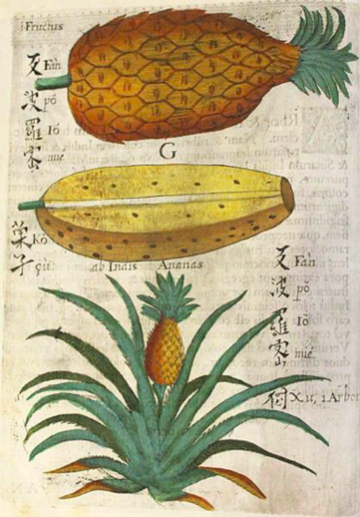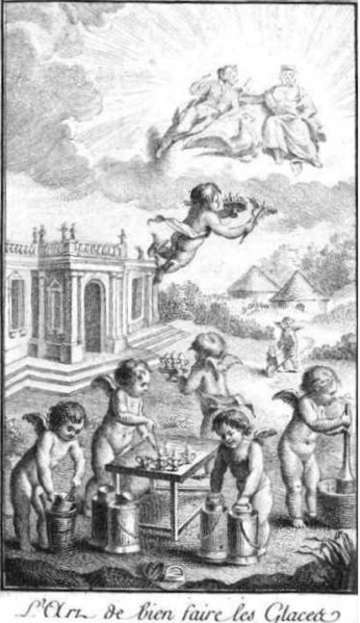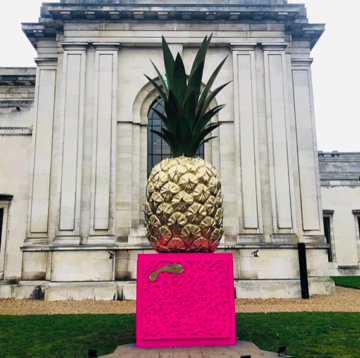Power, promise, politics: the pineapple from Columbus to Del monte
There are few conferences which bring together botanists, food historians, anthropologists, art historians, horticulturalists, geologists, economic historians, mathematicians, experts in literature (with specialisms ranging from 15th to 21st centuries), modern linguists, tourism and development professionals and plant ecologists. But the 2-day conference organised by Prof. Victoria Avery (Keeper of Applied Arts, Fitzwilliam Museum) and Dr Melissa Calaresu (Gonville and Caius; and Faculty of History), funded for the most part by the Centre for Research in the Arts, Social Sciences and Humanities, and held on day 1 in the Sainsbury Laboratory and on day 2 in the Bateman Auditorium at Gonville and Caius in February 2020 did exactly this.
As a Classicist, my connection to the pineapple is perhaps not immediately obvious (Greeks and Romans did not encounter them, as far as we know). My interest in the ‘prince of fruits’ stemmed from my stay in Honolulu, Hawaii in 2013-2014 as a US-UK Fulbright Visiting Professor at the University of Hawaii at Manoa. The legacy of the pineapple industry in Hawaii is visible across Oahu island. My Fulbright project on language education policy was my research priority while I was ‘on-island’, so I did not, alas, have much time to devote to unearthing the history of the pineapple industry. This conference in Cambridge, I hoped, would fill some gaps for me in helping me to understand the rise, fall and remnants of pineapple production on Oahu.
It did. In spades.
And it began with an olfactory ‘Pineapple Spectacular’ experience on the lawn outside the Fitzwilliam Museum.
https://www.youtube.com/embed/-nK573NhjBo
During the launch, conference delegates were given pineapple lollipops to taste while a huge pineapple-scented cloud burst from pots assembled at the foot of a giant, golden architectonic pineapple (Bompas and Parr created both the giant pineapple and the pineapple cloud experience).
From there, we walked to the Sainsbury Laboratory (an unnatural environment for a Humanities scholar – but the pineapple-shaped fairy lights in the auditorium put me at ease) in the Cambridge University Botanic Garden, the venue for the first day’s papers. You can access the programme here.
|
Day 1: Sainsbury Laboratory Auditorium For information about the location please visit the Laboratory's website. |
|
|
09.00-09.30 |
Fitzwilliam Museum, front lawn by giant Architectonic Pineapple Installation Optional Pineapple Multi-Sensory Presentation Sam Bompas and Rian Coulter (Bompas & Parr) |
|
09.30-10.00 |
Registration at Sainsbury Laboratory Auditorium |
|
10.00 |
Welcome and Opening Victoria Avery (Fitzwilliam Museum, Cambridge; Co-curator of Feast & Fast exhibition) |
|
10.15-11.45 |
Session 1: The Global Pineapple Chair: Melissa Calaresu (Gonville and Caius College, Cambridge) |
|
10.15-10.35 |
Rebecca Earle (School of Comparative American Studies, Warwick) 'From the Caribs to Carmen Miranda' |
|
10.35-10.55 |
Peter Crane (President, Oak Spring Garden Foundation, USA; former Director, Royal Botanic Gardens, Kew) [recorded video presentation] 'Maria Sibylla Merian, Metamorphosis and the Pineapple' |
|
10.55-11.15 |
Melissa Caldwell (Anthropology, UC Santa Cruz, and editor of Gastronomica: The Journal of Food and Culture) 'The Pineapple Between Tropical Imaginaries and American Mythologies' |
|
11.15-11.45 |
Discussion |
|
11.45-12.45 |
Session 2: The Edible Pineapple Chair: Deborah Krohn (Associate Professor, Bard Graduate Center, New York) |
|
11.45-12.05 |
Ivan Day (Independent Food Historian) ''As if Rosewater, Wine and Sugar was Mixed Together’: The Pineapple in the European Kitchen' |
|
12.05-12.25 |
Richard A Hawkins (Reader in History, University of Wolverhampton) 'Pineapple Processing and Canning from the Mid-Nineteenth Century to the Twenty-First Century' |
|
12.25 – 12.45 |
Discussion |
|
12.45-13.30 |
Lunch and time in the Botanic Garden |
|
13.30 – 15.00 |
Session 3: Optional Tours of the Cambridge University Herbarium and Cambridge University Botanic Garden Glasshouse Collections Optional tours of the Cambridge University Herbarium and Cambridge University Botanic Garden Glasshouse Collections with: Lauren Gardiner (Curator of the University Herbarium) Alex Summers (Glasshouse Supervisor) Barbara Griffith (Glasshouse Assistant) Mark Crouch (Deputy Head of Horticulture) Ángela Cano (Assistant Curator of the Botanic Garden)
or you have free access to the Botanic Garden grounds and café. |
|
15.00-16.30 |
Session 4: The Replicated Pineapple Chair: Francesca Beauman (Author of The Pineapple: King of Fruits) |
|
15.00-15.20 |
Emma Spary (Reader in History of Modern European Knowledge, Cambridge) 'Princely Fruit: The Pineapple in Print in Old Regime France' |
|
15.20-15.40 |
Melissa Calaresu (Neil McKendrick Lecturer in History, Gonville and Caius College, Cambridge) 'Pineapples and Pomegranates: Representing and Eating Exotic Fruit at the Early Modern Table, 1500–1800' |
|
15.40-16.00 |
Kasia Boddy (Reader in American Literature, English, Cambridge) 'The Poetic Pineapple: Some Literary and Filmic Uses of the Fruit' |
|
16.00-16.30 |
Discussion |
|
Day 2: The Bateman Auditorium, Gonville & Caius, Old Courts For information on the location please visit the College's website. |
|
|
Session 5: The Iconic Pineapple Chair: Dániel Margócsy (Lecturer in Science, Technology and Medicine before 1800, History and Philosophy of Science, Cambridge) |
|
|
09.30 – 09.50 |
Julie Hochstrasser (School of Art and Art History, University of Iowa) ''Familiar Exotic': The Pineapple in Seventeenth-Century Dutch Painting' |
|
09.50 – 10.10 |
Jonathan Swinton (author of Alan Turing's Manchester (2019)) 'The Beauty Myth: Why Pineapples Don't Need Protractors' |
|
10.10 – 10.30 |
Kathryn Jones (Senior Curator, Decorative Arts, Royal Collection Trust) ''A Profusion of Pines': The Pineapple in Architecture and the Decorative Arts' |
|
10.30 – 11.00 |
Discussion |
|
11.00 – 11.30 |
Break with Tea & Coffee |
|
11.30-13.00 |
Session 6: The Cultivated Pineapple Chair: Sujit Sivasundaram (Professor of World History, Cambridge) |
|
11.30 – 11.50 |
Lavinia Maddaluno (Warburg/I Tatti Joint Fellow) 'Pineapples, Roman Aristocracy and the Pope in Enlightenment Rome' |
|
11.50 – 12.10 |
Johanna Lausen-Higgins (Royal Botanic Garden, Edinburgh) 'Pineapple Mania – The Art of Cultivation in Eighteenth-Century Britain' |
|
12.10 – 12.30 |
Howard Griffiths (Professor of Plant Ecology, Plant Sciences, and Co-Chair of Cambridge Global Food Security IRC, Cambridge) 'Domestication of Wild Pine: How the Pineapple Works the Night Shift' |
|
12.30 – 13.00 |
Discussion |
|
13.00 – 14.00 |
Lunch (Bateman Room, Gonville and Caius College) |
|
14.00-15.30 |
Session 7: The Political Pineapple Chair: Melissa L. Caldwell (Anthropology, UC Santa Cruz, and editor of Gastronomica: The Journal of Food and Culture) |
|
14.00 – 14.20 |
Henry Knight Lozano (Exeter) 'A Settler Colonial Experiment: The Pineapple and American Hawai'i' |
|
14.20 – 14.40 |
Martin Mowforth (Visiting Specialist in Tourism and Development, Plymouth Business School, Plymouth) 'Dirty Pineapples from Costa Rica' |
|
14.40 – 15.00 |
Inanna Hamati-Ataya (Director, Centre for Global Knowledge Studies, CRASSH) 'The Traveling Pineapple: A Political History' |
|
15.00 – 15.30 |
Discussion |
|
15.30 – 15.45 |
Break (no refreshments provided) |
|
15.45-16.30 |
Session 8: Chairs' Concluding Round Table Chairs: Victoria Avery (Fitzwilliam Museum) and Melissa Calaresu (Gonville and Caius College) |
Historian Professor Rebecca Earle (Warwick) provided a fascinating overview of pineapples across time and space, ‘From the Caribs to Carmen Miranda’. She interwove Spanish literature from the 16th century, 18th century art and popular cultural ethnographies to give an illuminating introduction to the history of the pineapple. This was an excellent way to start the conference.
Dr Peter Crane (Oak Spring Garden Foundation) provided a paper by video. As a world-leading botanist, his paper was informed by research in botanical archives. Peter uncovered writings in Latin (Flora Sinensis) about pineapples by Michael Boym (1612-1659), a Jesuit missionary from Poland. Boym recorded the flora of China during his travels, including a beautiful image of a pineapple from 1656.
He also shared some of the archival records which refer to the descriptions of the flavour of pineapple. My favourite was this, ‘it tastes as though grapes, apricots, redcurrants, apples and pears had been mixed together all at once in it. Its scent is lovely and strong. When they are cut open, the whole room smells of it.’

Dr Melissa Caldwell (University of California at Santa Cruz) gave a historically informed and culturally sensitive paper on ‘The pineapple between tropical imaginaries and American mythologies’. An anthropologist, Melissa referred to the displacement caused by pineapple plantations in Hawaii, as well as the impact of mass immigration on Hawaii’s native culture and language. I was delighted to hear Melissa mention Professor NoeNoe Silva from the University of Hawaii at Manoa (whom I interviewed during my Fulbright year – it’s a small world). Melissa concluded that the history of the pineapple was both intriguing and troubling. She made connections between the pineapple and ‘paradise in decline’ in both her native Florida and Hawaii.
Ivan Day, food historian and broadcaster brought an 18th century ice-cream mould in the shape of a pineapple which he asked audience members to pass around during his talk, ‘As if Rosewater, wine and sugar was mixed together: The pineapple in the European Kitchen’. I learned about the engravings on confectioners’ and grocers’ trade cards and was delighted to see Classical cupids depicted as the messengers of ice-cream from mortals to the gods.

(Emy, Paris 1768)
Dr Richard Hawkins from the University of Wolverhampton provided an economic history of the pineapple by focussing on processing and canning from the mid-nineteenth to the twenty-first centuries. Richard provided a fascinating account of the pineapple ‘market’ while also addressing contentious issues like the ‘welfare capitalism’ offered by James D. Dole and the impact of scientific agriculture on the Hawaiian natural environment.
Lunch was catered by the Garden Café at the Cambridge University Botanic Garden and was a feast of plant-based deliciousness. And dessert was fresh pineapple, of course. Tours were available around the glasshouse collections and the herbarium with curators. By this point of the conference, I wondered why more conferences aren’t interdisciplinary by design? I had enjoyed conversations with a number of interesting people whose research cross-pollinated my own. I learned that food historians develop scratch-and-sniff wallpaper for pop-up museum exhibits. I laughed at the idea of Georgians renting pineapples for a few hours as a symbol of luxury, before handing over to the next party host. I discovered a whole new field: Plant Humanities. Watch this space – I hear a calling.
The afternoon’s papers were delightfully visual – more food! Historian Dr Melissa Calrescu (Cambridge) included both pineapples and pomegranates in her paper about representing and eating exotic fruit 1500-1800.
And Dr Kasia Boddy (Cambridge) showcased the uses of pineapple in contemporary English literature and film. She included references to pineapple rings on toast and cheese and pineapple sticks in a tinfoil hedgehog from Jeanette Winterson’s ‘Why be happy when you could be normal?’ (2011).
This conference provided rich opportunities for diversely situated researchers to share knowledge, skills and experiences. I developed new, mutually beneficial partnerships and left buzzing with ideas for interdisciplinary collaboration. For me, investing a day of my time at this event (slightly beyond the boundaries my academic field) certainly bore fruit.
CRASHH has created a wakelet summary of the conference. Every talk from the conference was audio-recorded and is freely accessible on the CRASSH website.
You can learn more about Dr Arlene Holmes-Henderson's work here and follow her on twitter at @drarlenehh. Enjoy a preview of her one of her recent publications, Forward with Classics: Classical Languages in Schools and Communities, edited by Arlene Holmes-Henderson, Steven Hunt, and Mai Musié here. Listen to the Book at Lunchtime panel discussion for this text here.



